The air/vapor barrier must die
by sadia_badhon | August 21, 2019 10:04 am
 [1]SPECIFICATIONS
[1]SPECIFICATIONS
by Juste Fanou
The terms ‘air barriers’ and ‘vapor retarders’ (or ‘vapor barriers’) are perhaps some of the most poorly understood concepts in the construction industry. Most building professionals know they are needed, but often struggle to locate them correctly within wall assemblies. Also, the consequences of installing these materials improperly can result in failures. This lack of understanding of the functions of these assemblies has resulted in simplistic rules-of-thumb prone to misapplication (e.g. the vapor barrier is always on the inside and the air barrier is always on the outside). As manufacturers introduce materials with new properties and attempt to push the boundaries of building envelope construction, it is crucial the industry agrees on terminology for communicating the specific functions and purpose of these materials to avoid confusion and costly errors. In this regard, the term ‘air/vapor barrier’ is misleading and should be replaced with more appropriate terminology.
A brief history
 [2]
[2]Initial attempts to increase the thermal comfort of occupants in modern North American wood-framed construction date back to the 1800s. The introduction of ‘building paper’ in the form of asphalt-impregnated felt—also known as sheathing membranes or weather-resistive barriers (WRBs)—represented an early effort to reduce wetting of wall assemblies and air leakage (Refer the 2017 book Building Materials: Product Emission and Combustion Health Hazards written by K. Hess-Kosa). The industry made further advancements in the field of envelope performance in the 1930s with the rise of insulation in framing cavities and attics (For more information, read the article, “Heat, Air and Moisture Control in Walls of Canadian Houses: A Review of the Historic Basis for Current Practices,” by M. Koniorczyk and D. Gawin, published in the April 2008 issue of Journal of Building Physics). However, the undesirable effects of moisture in insulated cavities soon surfaced. The traditionally painted wood façades began to suffer from peeling, blistering, and other coating failures. As is the norm in the building industry, a ‘blame game’ quickly ensued with insulation manufacturers blaming the paint producers and vice-versa, while the building paper manufacturers were caught in the middle (Consult the paper, “The rise of the diffusion paradigm in the US,” by W.B. Rose, published in the 2003 book, Research in Building Physics: Proceedings of the Second International Conference on Building Physics, edited by G. V. J. Carmeliet, H. Hens, and G. Vermeir). It was not until the late 1930s that scientists began investigating moisture movement in building assemblies. Their findings—considered controversial or even biased by some—concluded the transfer of water vapor by diffusion (a process explained later in this article) was responsible for the paint peeling off the siding (Many argue Frank Rowley’s theory of vapor diffusion, which led to the introduction of vapor barriers in wall cavities and ventilated attic spaces, was not grounded in sound science. This study is considered biased by many in the field, because it was funded by the insulation industry as a way to defend itself against claims insulation was responsible for condensation in cavity spaces and peeling paint). These conclusions resulted in regulation that mandated the use of low-vapor permeance membranes in construction projects in the early 1950s. It was the birth of the ‘vapor barrier,’ and the industry celebrated its solution to the moisture problem by lining walls with polyethylene (PE) plastic. Ostensibly the issue of peeling paint was resolved, or at least it seemed so.
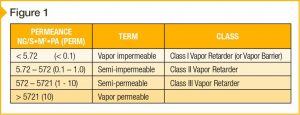 [3]
[3]Image courtesy J. Lstiburek
Nonetheless, moisture problems persisted. Further research in the mid-1980s[4] suggested that uncontrolled air infiltration, and not vapor diffusion, was the largest contributor to moisture accumulation in cavity spaces. However, by that time the popularity of the now ubiquitous ‘6-mil poly’ inspired methods to seal the already familiar vapor barrier. The purpose was to turn it into an effective air barrier.
These attempts to seal the vapor barrier may be characterized as the genesis of the ‘air/vapor barrier,’ both as a concept and term. Conceptually, the ‘air/vapor barrier’ was a material purported to address both air infiltration and vapor diffusion issues. Its proponents believed in sealing the joints of PE sheets to create a dual-purpose material ascribing the additional properties of air infiltration control to the already popular ‘6-mil poly.’ This popularity was perhaps responsible for its great appeal and wide adoption in the industry. As time passed, however, the idea of ‘sealing PE was quickly abandoned, and construction practitioners explored other materials to provide airtightness. It was clear PE was not a sufficiently durable material to resist the effects of wind gusts and pressures. Moreover, this lack of durability was further undermined by the intrinsic difficulties associated with installing PE in a continuous fashion.
Even if the concept of the PE ‘air/vapor barrier’ slowly faded, the term continued to be used. Coincidentally, as time passed it also appeared as if the general understanding of the functions of these air and moisture control elements was further clouded by this conflated term. These once-distinct materials slowly transformed into abstract dotted lines everyone knew were required on construction details, but no one fully understood where or why.
Differences
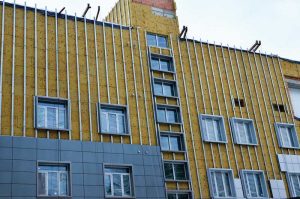 [5]
[5]Photo © BigStockPhoto.com
The building envelope performs very important tasks. Its primary purpose is to protect conditioned spaces from the adverse effects of heat, air, water, and vapor. In other words, it keeps the outside out, and the inside in. This is achieved through a combination of carefully selected layers designed to stop and/or drain bulk water, insulate against heat loss, prevent or reduce air leakage, and slow down vapor migration. In building science settings, these are referred to as control layers[6]. Air barriers and vapor barriers are part of these control layers.
Air barriers, as its name implies, are intended to stop uncontrolled air from leaking into conditioned spaces. This infiltration is caused by the effects of wind[7], HVAC systems, and by air buoyancy forces, also known as ‘the stack effect.’ It is critical to stop uncontrolled air leakage because air can act as a transport mechanism for several other undesirable particulates (e.g. smoke and odor). Additionally, air can also carry moisture. However, the maximum amount of moisture air can carry (its saturation point) is dependent on temperature and pressure. Generally, cold air can carry less moisture than warm air.
When saturated air encounters a cooler surface, the moisture it is carrying undergoes a phase change and condenses (i.e. turns from gas to liquid) on the surface. The temperature at which this occurs is known as the dewpoint. This becomes critical in building envelope design because uncontrolled air leakage can result in air entering and condensing on components of wall cavities in unintended ways, leading to moisture-related problems such as mold, corrosion, and the general deterioration of building materials.
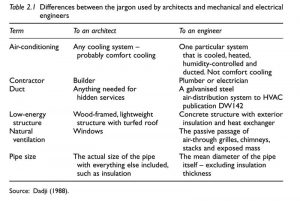 [8]
[8]Images courtesy J. Lstiburek
Air barriers are installed to counteract these undesirable effects, and must at a minimum possess some essential properties.
Resistant to air leakage
This resistance is quantified through testing according to industry standards (ASTM E2178, Standard Test Method for Air Permeance of Building Materials). The Air Barrier Association of America (ABAA) limits the air leakage of materials used for air barrier systems in opaque wall assemblies to 00.02 L/s.m2 (0.004 cfm/sf) at a pressure differential of 75 Pa (1.57 psf).
Be continuous
As shown by research, air leakage is a critical factor when it comes to ensuring proper building envelope performance. Therefore, most governing codes stipulate for materials that are employed to preserve the airtightness of building assemblies to be installed in a continuous fashion.
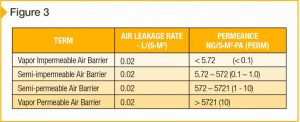 [9]
[9]Act as a system
Contrary to popular belief, the air barrier does not manifest itself as a single material. Even if there is
a primary air barrier material (usually referred to as the air barrier membrane), it is the combination of this primary material and various other components (e.g. doors and windows) and accessories (e.g. sealants and tapes) performing in unison that truly guard the building against the deleterious effects of air leakage. This systemic approach is recognized in ASTM E2357, Standard Test Method for Determining Air Leakage Rate of Air Barrier Assemblies, as it attempts to simulate a full system approach (e.g. continuity, penetrations, and interfaces) rather than evaluate the performance of materials in isolation. Air leakage for such assemblies is limited by ABAA to 0.2 L/(s·m2) (0.4 cfm/sf) of leakage at a pressure differential[10] of 75 pa.
Vapor retarders (or vapor barriers) serve a much different purpose than air barriers. They are designed to stop (or slow) the movement of water in its gaseous form from traveling through wall assemblies. This process, called vapor diffusion, is the motion of water vapor molecules from an area of high concentration (higher humidity) to an area of low concentration (lower humidity) across a gradient (vapor permeable material). This movement is driven largely by kinetic forces at the molecular level and is governed by temperature and relative humidity (RH), and not air pressure.
Vapor permeance (colloquially referred to as ‘perm rating’) is a measure of a material’s ability to allow the passage of moisture by diffusion. This is expressed in perms, and is often evaluated in accordance with ASTM E96, Standard Test Methods for Water Vapor Transmission of Materials. Building codes have classified materials according to their vapor permeance[11] on a scale ranging from ‘vapor impermeable’ to ‘vapor permeable’ and assigned them to ‘vapor retarder classes’ ranging from I to III. In principle, only materials meeting the requirements of a ‘Class I Vapor Retarder’ should be called ‘vapor barriers’ (Figure 1).
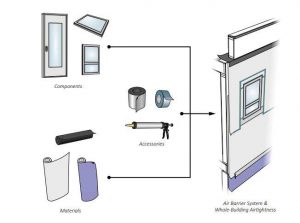 [12]
[12]Diffusion rates through wall assemblies have been shown to be generally slow. All things being equal, breaches in the vapor barrier result in significantly lower quantities of moisture migration as a result of diffusion rather than the quantity of moisture transported through the same material due to air movement. As such—despite what many often assume—vapor barriers need not be continuous in wall assemblies, and may, at times, (depending on climate) be omitted altogether.
Different meanings
The importance of effective communication in the construction industry cannot be overstated. However, barriers (no pun intended) exist that can impede or distort effective communication and result in failure or undesirable effects. Amongst these barriers, the use of jargon is often cited as a leading cause of communication breakdown. Specifically, in the construction industry—due to its fragmented structure, technical nature, and the adversarial tendencies of its stakeholders—the lack of terminology standardization has engendered different terms and meanings that are understood differently across actors. Figure 2 illustrates how misunderstandings can occur between two professionals interpreting technical jargon differently. Unfortunately, these complex and ambiguous terms, often well-understood by discrete groups, but prone to misinterpretation by others, plague the industry.
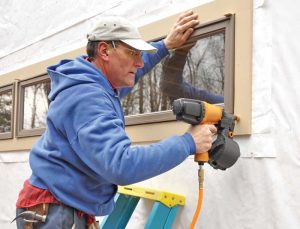 [13]
[13]Photo © BigStockPhoto.com
The term ‘air/vapor barrier’ is an example of such ambiguous terminology. The ambiguity of this term is inherent in its use of the slash ( / ) punctuation mark. In English, the slash can be used to either denote ‘or’ or ‘and.’ Therefore, in theory, the term ‘air/vapor barrier’ can be interpreted as ‘air or vapor barrier’ or ‘air and vapor barrier.’ In general contexts, however, it is safe to assume most people use it to refer to the latter. Yet, as it has been discussed previously, the term ‘vapor barrier’ is itself a subset of the term ‘vapor retarder’ (i.e. only a Class I vapor retarder is considered a vapor barrier). Should the term ‘air/vapor barrier’ then be restricted to materials meeting the requirements for air barrier materials and Class I vapor retarders? The advent of materials having various levels of permeability (e.g. spun-bonded polyolefin, silicone, and vapor permeable polyurethane foam) clearly show such a restriction would prove overly exclusive.
Any alternative to ‘air/vapor barrier’ should reduce ambiguity while reflecting the current trends of the industry. At present, we understand the benefits of controlling air leakage clearly outweigh the control of vapor diffusion. Therefore, ‘air/vapor barrier’ should be replaced with a term describing an air barrier material, which also has some vapor-retarding characteristics. As the permeability of materials has already been standardized in building codes, it is perhaps most appropriate to borrow this terminology and apply it to the problem under discussion. See Figure 3 for a proposed system with four distinct designations and associated properties.
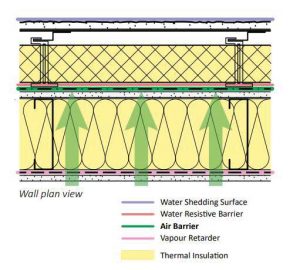 [14]
[14]Image courtesy J. Lstiburek
Conclusion
It is no secret the construction industry is plagued by a chronic productivity problem. A 2015 report[15] by McKinsey & Company showed that while productivity rates in the manufacturing sector nearly doubled over the 20-year period spanning from 1995 to 2015, productivity rates remained painfully flat, or even worsened, in the construction industry. Factors such as the fragmented structure of the industry, the cyclical nature of construction activities, and poor or inadequate communication have all been suggested as contributors to this lack of productivity growth. Moreover, these sluggish gains may also be reflective of the industry’s unwillingness to embrace change.
The future is, however, not all bleak. Recent years have shown consultants and contractors alike embrace new technologies such as building information modeling (BIM), drones, and prefabrication to increase output and reduce errors. Accordingly, the language used in construction today must express and reflect the current state of affairs. Terms and materials no longer serving their purpose should be retired and replaced with new ones illustrating advancements in research and practice.
Thus, the term ‘air/vapor barrier’ should be replaced by ones illustrating both the air leakage and vapor permeance properties of these materials. Ultimately, the biggest challenge to any term proposed will be to overcome the inertia forces associated with the construction industry’s fear of change.
The opinions expressed in Specifications are based on the author’s experiences and do not necessarily reflect those of The Construction Specifier or CSI.
Juste Fanou is the director of Jm|F Technical Documentation Solutions Inc. He is a bilingual technical documentation specialist and specifications writer with more than 10 years of experience. Fanou has assisted multiple clients in the development of front-end and technical specifications including the evaluation of material substitution proposals, and the interpretation of standards. He holds a certificate in building science, a diploma in architectural technology, and a degree in civil engineering technology. Fanou can be reached at jfanou@jmfservices.net[16].
- [Image]: https://www.constructionspecifier.com/wp-content/uploads/2019/08/headshot.jpg
- [Image]: https://www.constructionspecifier.com/wp-content/uploads/2019/08/bigstock-Background-Of-Concrete-And-Gla-230098453.jpg
- [Image]: https://www.constructionspecifier.com/wp-content/uploads/2019/08/figure-1.jpg
- research in the mid-1980s: https://nrc-publications.canada.ca/eng/view/accepted/?id=db9bccc2-eff6-4249-8a3f-0d2224dc30db
- [Image]: https://www.constructionspecifier.com/wp-content/uploads/2019/08/bigstock-Insulation-For-Thermal-Protect-280686688.jpg
- control layers: http://buildingscience.com/documents/insights/bsi-001-the-perfect-wall
- effects of wind: http://www.bchousing.org/research-centre/library/residential-design-construction/achieving-airtight-buildings
- [Image]: https://www.constructionspecifier.com/wp-content/uploads/2019/08/Figure-2.jpg
- [Image]: https://www.constructionspecifier.com/wp-content/uploads/2019/08/figure-3.jpg
- pressure differential: http://www.airbarrier.org/technical-information/evaluated-assemblies-2
- vapor permeance: http://buildingscience.com/documents/digests/bsd-106-understanding-vapor-barriers
- [Image]: https://www.constructionspecifier.com/wp-content/uploads/2019/08/Illustration-1.jpg
- [Image]: https://www.constructionspecifier.com/wp-content/uploads/2019/08/bigstock-Carpenter-using-nail-gun-to-in-30407747.jpg
- [Image]: https://www.constructionspecifier.com/wp-content/uploads/2019/08/Illustration-3.jpg
- 2015 report: http://www.mckinsey.com/industries/capital-projects-and-infrastructure/our-insights/the-construction-productivity-imperative
- jfanou@jmfservices.net: mailto:jfanou@jmfservices.net
Source URL: https://www.constructionspecifier.com/the-air-vapor-barrier-must-die/